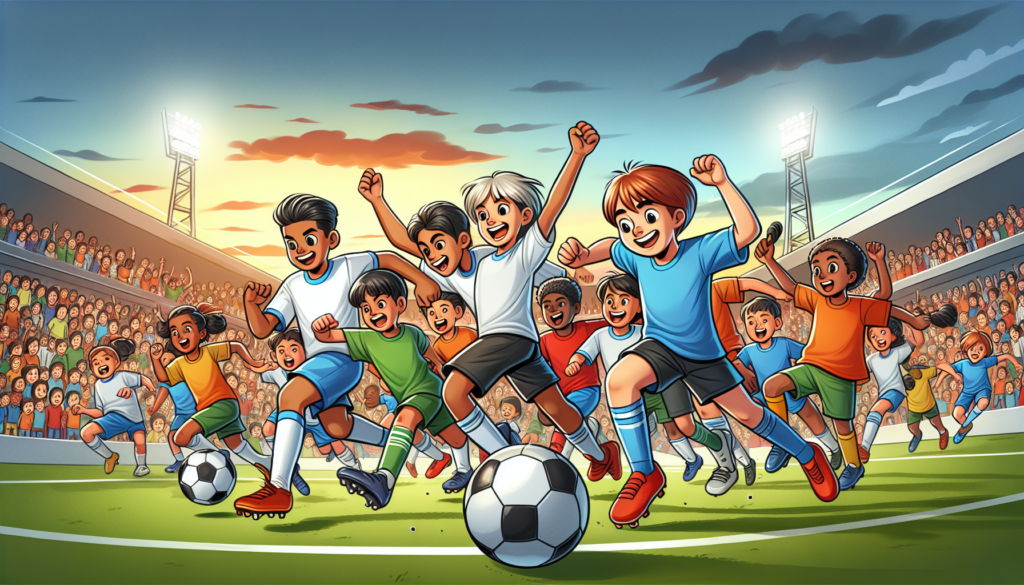
Imagine a world where boys and girls could play soccer together on the same team, breaking down gender barriers and challenging traditional norms. This thought-provoking question begs us to consider if skill and passion should be the defining factors rather than gender. In this article, we will explore the potential benefits of allowing girls and boys to play on the same soccer team, examining the positive impact it could have on inclusivity, skill development, and ultimately, the beautiful game itself.
Benefits of Mixed-Gender Soccer Teams
Promotes Equality
One of the main benefits of having mixed-gender soccer teams is that it promotes equality. By allowing both girls and boys to play on the same team, it sends a powerful message that everyone is equal, regardless of their gender. This helps to eliminate any gender biases or stereotypes that may exist in traditional single-gender teams. It also allows players to interact and collaborate with individuals of different genders, fostering a sense of inclusivity and respect.
Fosters Collaboration and Communication
Another advantage of mixed-gender soccer teams is that they foster collaboration and communication among players. When both genders are working together towards a common goal, it encourages them to collaborate effectively and communicate with each other. This is beneficial not only on the field but also in other areas of life, as it helps to develop important social and teamwork skills. Players learn to understand and appreciate different communication styles and perspectives, which can improve their overall ability to work with diverse groups of people.
Physical Differences between Girls and Boys
Strength and Endurance
It is important to acknowledge that there are physical differences between girls and boys. In general, boys tend to have more muscle mass and strength, while girls typically have higher endurance levels. However, these differences can vary on an individual basis and should not be seen as a determining factor for whether or not they can play on the same team. By training and conditioning appropriately, both girls and boys can develop the necessary physical abilities to excel in soccer.
Speed and Agility
When it comes to speed and agility, girls and boys may also differ due to factors such as hormonal differences and body composition. Boys often have higher testosterone levels, which can contribute to greater speed and agility. However, it is important to note that there are many highly skilled and fast female soccer players who can match or even surpass their male counterparts. Therefore, it should not be assumed that girls are inferior in these aspects or that they cannot compete on an equal level with boys.

Psychological Factors to Consider
Social Challenges
Allowing girls and boys to play on the same soccer team may present social challenges for some individuals. Some players may feel uncomfortable initially as they are not used to playing alongside individuals of the opposite gender. However, over time, these challenges can be overcome through open communication, team-building exercises, and fostering a supportive team environment. Coaches and team leaders play a crucial role in ensuring that all players feel included and valued, helping to ease any social challenges that may arise.
Gender Stereotypes
Gender stereotypes are another psychological factor that needs to be taken into consideration when forming mixed-gender teams. It is essential to create an environment where players are not restricted by stereotypes and can fully express themselves on the field. By challenging and breaking down these stereotypes, mixed-gender soccer teams can empower players to embrace their unique skills and abilities, regardless of societal expectations.
Coaching and Training Adaptations
Skill Development
Coaching and training adaptations are necessary to cater to the unique needs of both girls and boys on mixed-gender soccer teams. Coaches should focus on individual skill development, providing equal opportunities for girls and boys to improve and showcase their abilities. Special attention should be given to addressing any physical differences, such as strength or speed, by designing training programs that cater to each player’s specific needs. By placing emphasis on skill development, coaches can help players reach their full potential and contribute to the success of the team.
Training Techniques
Different training techniques may also be employed to accommodate the varying physical attributes and abilities of girls and boys. For example, strength training exercises may be included in the training program for girls to help improve their muscular strength and endurance. On the other hand, agility drills may be emphasized for boys to enhance their speed and quickness. By tailoring training techniques to the unique needs of each player, coaches can ensure that all players have the opportunity to enhance their skills and contribute effectively to the team’s success.

Potential Challenges of Mixed-Gender Teams
Competitive Disparities
One potential challenge of mixed-gender soccer teams is the presence of competitive disparities. Due to the physical differences between girls and boys, there may be instances where one gender outperforms the other in certain aspects of the game. This can lead to feelings of frustration or inequality among players. Coaches and team leaders should address these disparities by focusing on skill development, maintaining fair competition, and emphasizing the importance of teamwork over individual performance. By fostering a supportive and inclusive team culture, the competitive disparities can be minimized, allowing all players to contribute to the team’s success.
Risk of Injury
Another challenge to consider is the potential risk of injury in mixed-gender teams. Soccer is a physical sport that requires players to engage in intense physical contact and movement. Girls may be at a higher risk of certain injuries, such as ACL tears, due to differences in anatomical structures and hormonal factors. It is crucial for coaches to prioritize player safety by implementing proper training techniques, ensuring that players are adequately conditioned, and providing guidance on injury prevention. Additionally, creating an environment where players can openly communicate any concerns or discomfort can help mitigate injury risks.
Successful Examples of Mixed-Gender Soccer Teams
Professional and National Teams
There have been successful examples of mixed-gender soccer teams at the professional and national level. In some countries, such as Sweden and the Netherlands, mixed-gender teams have been established to promote gender equality and provide opportunities for both male and female players to compete together. These teams have demonstrated that with the right support, coaching, and training, mixed-gender teams can thrive and achieve remarkable success.
Youth and Amateur Leagues
Mixed-gender soccer teams have also shown success in youth and amateur leagues worldwide. Many young players are introduced to the game through mixed-gender teams, allowing them to develop their skills and passion for soccer in a diverse and inclusive environment. By starting at a young age, players have the opportunity to grow and learn alongside teammates of different genders, breaking down barriers and establishing strong friendships and bonds.

Factors Influencing the Decision
Age of Players
The age of players is an important factor to consider when determining whether girls and boys can play on the same soccer team. Younger players, especially at the grassroots level, may not exhibit significant physical differences that could impact their performance. As players get older and progress to higher levels of competition, physical disparities may become more pronounced. Therefore, it is important to assess the age and physical development of players when making decisions regarding mixed-gender teams.
Level of Competition
The level of competition also plays a role in determining whether mixed-gender teams are suitable. In recreational leagues or non-competitive environments, the focus may be more on providing opportunities for all players to enjoy the game together rather than solely on performance. However, in elite or higher-level competition, the physical differences between girls and boys may become more pronounced, potentially impacting the fairness and competitiveness of the game. Coaches and league officials should consider these factors when deciding the feasibility of mixed-gender teams at different levels of competition.
Personal Preferences
Lastly, personal preferences of players and their families should be taken into account. Some players may feel more comfortable playing on single-gender teams due to personal or cultural reasons, while others may actively seek the opportunity to play alongside individuals of different genders. By respecting individual preferences, organizations can create an environment that accommodates the needs and desires of all players, ensuring that they have a positive and fulfilling soccer experience.
The Importance of Inclusivity and Diversity in Sports
Breaking Gender Barriers
The inclusion of mixed-gender soccer teams is an important step towards breaking down gender barriers in sports. By challenging the traditional norms and allowing both girls and boys to play together, it sends a powerful message that everyone deserves equal opportunities to participate in sports, regardless of their gender. This promotes a more inclusive and diverse sporting culture where talent and passion are recognized above societal expectations or gender stereotypes.
Empowering Girls
Mixed-gender soccer teams can also have a significant impact on empowering girls in sports. By being exposed to a diverse range of players and skill levels, girls are more likely to develop confidence and self-belief in their own abilities. They can see firsthand that they are capable of competing at the same level as their male counterparts and can excel in a sport that has traditionally been dominated by boys. This empowerment extends beyond the soccer field, allowing girls to envision themselves succeeding and breaking barriers in other areas of life.

Guidelines for Creating a Safe and Inclusive Environment
Establishing Clear Policies
To ensure that mixed-gender soccer teams thrive in a safe and inclusive environment, it is essential to establish clear policies and guidelines. These policies should address issues such as fair play, equal opportunities, non-discrimination, and respectful behavior. It is important that all players, coaches, and team officials understand and adhere to these policies, creating an atmosphere of respect, inclusivity, and sportsmanship.
Addressing Bullying and Discrimination
It is also crucial to address the possibility of bullying and discrimination in mixed-gender teams. Coaches, officials, and parents should be vigilant in identifying and addressing any instances of bullying, harassment, or discriminatory behavior. By fostering an open and supportive environment where players feel safe to report such incidents, swift action can be taken to rectify the situation and protect the well-being of all team members.
Conclusion
The inclusion of mixed-gender soccer teams brings numerous benefits, promoting equality, collaboration, and communication among players. While physical and psychological differences may exist between girls and boys, proper coaching, training adaptations, and a focus on individual skill development can overcome these challenges. Mixed-gender teams have shown success at both professional and amateur levels, providing opportunities for inclusivity and diversity in sports. Factors such as player age, level of competition, and personal preferences should be considered when forming these teams. By ensuring a safe and inclusive environment, we can break gender barriers, empower girls, and create a more equitable and diverse sporting landscape.
